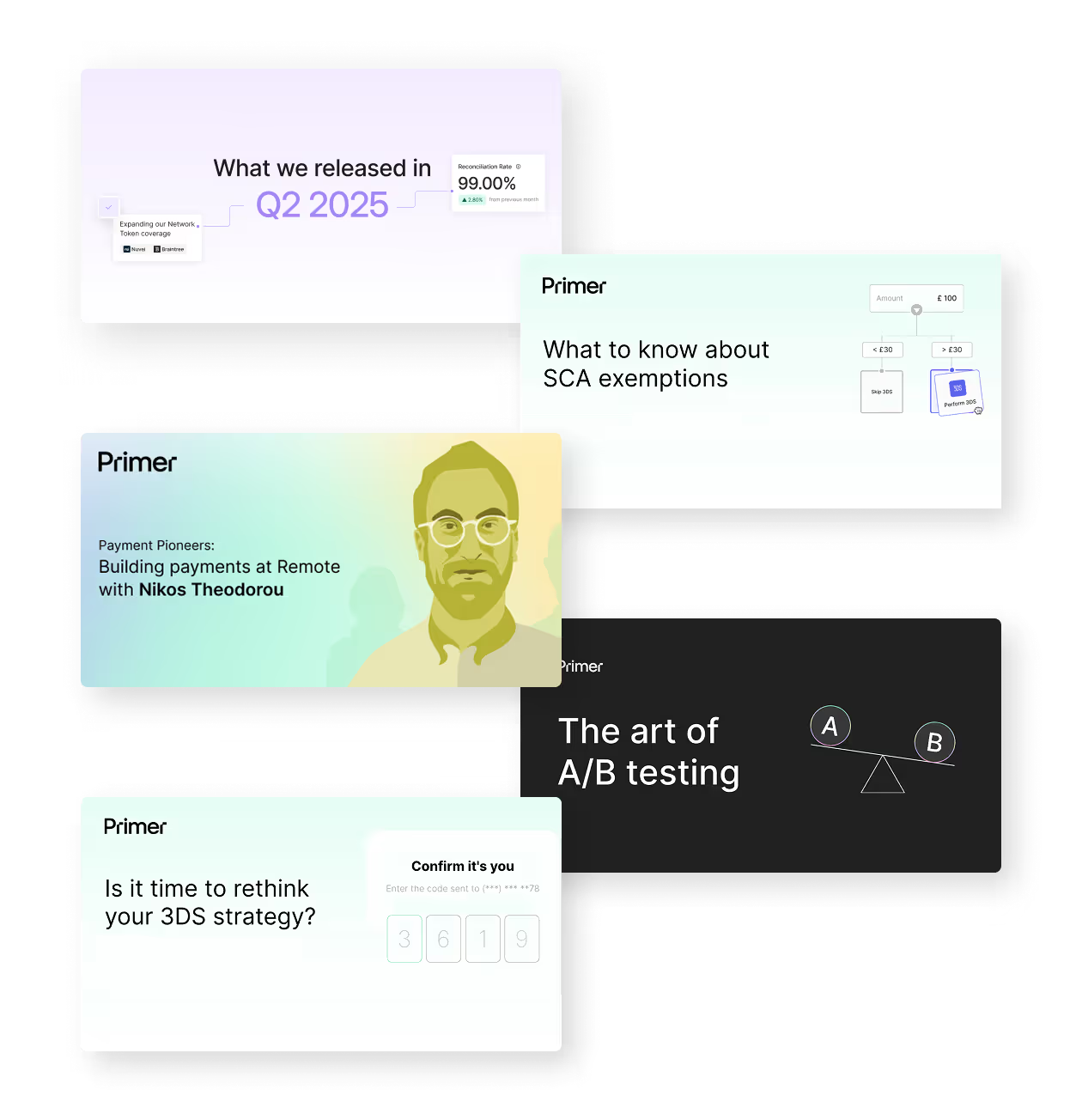In a perfect world, payment processing would be seamless and predictable—but the reality is far more complex. Each transaction is subject to countless variables, and issues can arise at any moment, potentially leading to revenue loss and customer dissatisfaction.
The ability to quickly identify and resolve these issues is critical. However, most merchants lack the necessary payment monitoring systems to monitor payments in real-time.
As a result, they tend to focus primarily on the operational aspect—such as identifying and resolving issues when 'things are failing'—without giving enough attention to critical payment KPIs like authorization rates, which are just as crucial to overall performance.
This leaves businesses vulnerable to revenue leakage and poor customer experiences.
That's why we developed Primer Monitors. Our payment monitoring solution empowers you to track key payment metrics in real-time and set up customizable alerts, ensuring your team stays informed and can take immediate action whenever something goes wrong.
Setting up a Primer Monitor
Setting up payment monitoring in Primer is simple and requires no coding. Plus, it's highly flexible, allowing you to customize monitors for your specific business needs.
Let's look at the components you can use to build a monitor in Primer.
Dynamic or static payment monitors
You have two options when setting up a monitor:
- Dynamic Payment Monitor: This monitor compares performance using your historical payment data and sends an alert if there's an unexpected deviation from the historical benchmark. It's ideal for businesses with stable, predictable metrics.
- Static Payment Monitor: This lets you set a fixed threshold. The monitor will trigger whenever that threshold is exceeded, like when a certain number of payments fail within a given period.
You can use both types together for a comprehensive monitoring setup that fits your needs.
Metric
Primer allows you to track various payment metrics, such as:
- 3DS authentication rate
- Authorization rate
- Decline rate
- Payment count
You can set specific thresholds for each. For example, you might want to be alerted if your authorization rate falls below 90% or when more than 20 payments fail.
Time period
You can further refine your monitor by defining the time period. For example, you may only want an alert if your authorization rate stays below 90% or when more than 20 payments fail within the past hour.
Additional filters
To get even more specific, you can apply filters. For instance, you might want the alert only for customer-initiated transactions where the authorization rate stays below 90% or when more than 20 payments fail within the past hour.
Payment count
Lastly, you can specify how many payments must be processed before the monitor triggers. This helps reduce unnecessary alerts and gives you more control.
Getting alerted to processing changes
To ensure you’re instantly notified of any payment issues, Primer lets you create custom alerts that integrate seamlessly with the business tools you already use, such as Slack, Email, and PagerDuty. This way, your team is always in the loop and can act quickly when something goes wrong.
Setting up these alerts within Primer’s Workflow is simple and highly flexible, allowing you to tailor notifications to your needs. For example:
- PagerDuty Alert for Engineering: Trigger an incident in PagerDuty when a payment failure alert goes off, signaling a potential technical issue.
- Slack Message for Payment Managers: Send yourself a Slack notification when an authorization rate alert is triggered. This will allow you to investigate and possibly reroute transactions.
- Email for Customer Support: Notify customer support via email when the refund count crosses a threshold so they can take action.
.avif)
You can fully customize the content of each alert, automatically pulling relevant payment data from Primer to ensure every team has the necessary context.
.avif)
Debugging processing events
Once alerted, you can access all the necessary details through the Event Detail page in the Primer Monitors application.
This page shows why the event was triggered and its impact beyond the initial alert. You’ll also find a list of relevant payments to review and debug, as well as other related events that occurred simultaneously.
This view is essential for quickly identifying the root cause of the issue and determining whether it’s something you, as a merchant, can address.
.avif)
Payment metrics to track using Primer Monitors
Now that you’re familiar with Primer Monitors, let’s explore some essential payment metrics you should consider tracking and how to respond.
#1 Number of failed payments
Payment failures are inevitable, but a sudden spike can signal a more serious issue, such as your primary processor going down.
For instance, one merchant recently encountered downtime with their primary processor. With the help of a Primer Monitor, they were alerted when the failure rate exceeded a predefined threshold. While investigating, they swiftly switched to a backup processor, ensuring uninterrupted customer checkout.
Catching issues like this early can prevent substantial revenue loss.
#2 Authorization rate
Authorization rates naturally fluctuate, but when they dip sharply or for a prolonged period, you need to act fast. This could signal problems with a particular processor or payment method.
For example, if you’re alerted to a dip in authorization rate dips with Processor A, you can switch to Processor B while investigating the issue.
Or, say, a specific payment method starts experiencing a steep decline in approvals. With Primer’s Universal Checkout, you can easily turn off that method in just a few clicks, ensuring your customers experience minimal disruption while you work behind the scenes to fix the issue.
#3 3DS Authentication rate
3D Secure (3DS) authentication is crucial to protecting online payments, but it can also introduce more opportunities for errors. Keeping an eye on your 3DS performance is essential because a spike in authentication failures could hurt your conversion rates.
If you notice a surge in 3DS failures, you can leverage exemptions for low-risk transactions or prioritize frictionless flows for trusted users to ensure a seamless payment process while keeping fraud controls.
#4 Total number of payments processed
Most merchants prepare for predictable payment surges, whether it’s holiday shopping seasons or high-demand events like concert ticket sales. But what about those unexpected spikes? Real-time alerts are critical in those moments.
If demand surges unexpectedly, Primer’s Split Utility helps distribute payment traffic across multiple processors, preventing overload and ensuring a seamless payment experience.
On the flip side, if the surge is caused by fraud—such as a large-scale card testing attack—Primer helps you detect and block suspicious activity in real-time, protecting your business from potential damage.
#5 Refund rate
Keeping track of your refund rate is key to maintaining profitability and gaining insights into customer satisfaction.
A rising refund rate could indicate operational issues or even fraud. By actively monitoring this metric, we can help you spot trends early and take steps to protect your business and improve decision-making.
Stay informed with Primer's payment monitoring system
In an ideal world, merchants wouldn't need alerts because payments would run flawlessly. But we know that's not the reality. As the saying goes, "Forewarned is forearmed."
Getting timely alerts about performance issues allows you to act fast, resolve problems before they escalate, and protect your revenue.




(1).png)
.png)